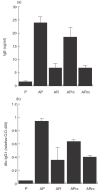Intranasal delivery of a truncated recombinant human SP-D is effective at down-regulating allergic hypersensitivity in mice sensitized to allergens of Aspergillus fumigatus
- PMID: 12296848
- PMCID: PMC1906502
- DOI: 10.1046/j.1365-2249.2002.01968.x
Intranasal delivery of a truncated recombinant human SP-D is effective at down-regulating allergic hypersensitivity in mice sensitized to allergens of Aspergillus fumigatus
Abstract
C57BL/6 mice were sensitized to Aspergillus fumigatus 1-week culture filtrate, which is rich in the non-glycosylated allergen Asp f1, a major allergen in allergic bronchopulmonary aspergillosis (ABPA). A comparison of the effect of treatment of allergen challenged mice by intranasal administration of a 60-kDa truncated recombinant form of human SP-D (rfhSP-D) or recombinant full length SP-A (rhSP-A) was undertaken. Treatment with rfhSP-D produced significant reduction in IgE, IgG1 and peripheral blood eosinophilia and treatment with rfhSP-D, but not rhSP-A resulted in a significant reduction in airway hyperresponsiveness as measured by whole body plethysmography. Lung histology revealed less peribronchial lymphocytic infiltration in mice treated with rfhSP-D. Intracellular cytokine staining of spleen homogenates showed increases in IL-12 and IFN-gamma and decrease in IL-4. The level of endogenous mouse SP-D was elevated sixfold in the lungs of sensitized mice and was not affected by treatment with rfhSP-D. Taken with our previous studies, with a BALB/c mouse model of ABPA using a 3-week A. fumigatus culture filtrate, the present results show that rfhSP-D can suppress the development of allergic symptoms in sensitized mice independent of genetic background and using a different preparation of A. fumigatus allergens.
Figures







Similar articles
-
Susceptibility of mice genetically deficient in the surfactant protein (SP)-A or SP-D gene to pulmonary hypersensitivity induced by antigens and allergens of Aspergillus fumigatus.J Immunol. 2005 Jun 1;174(11):6943-54. doi: 10.4049/jimmunol.174.11.6943. J Immunol. 2005. PMID: 15905537
-
Surfactant proteins A and D protect mice against pulmonary hypersensitivity induced by Aspergillus fumigatus antigens and allergens.J Clin Invest. 2001 Feb;107(4):467-75. doi: 10.1172/JCI10124. J Clin Invest. 2001. PMID: 11181646 Free PMC article.
-
A recombinant fragment of human SP-D reduces allergic responses in mice sensitized to house dust mite allergens.Clin Exp Immunol. 2003 Nov;134(2):181-7. doi: 10.1046/j.1365-2249.2003.02281.x. Clin Exp Immunol. 2003. PMID: 14616775 Free PMC article.
-
Protective roles of pulmonary surfactant proteins, SP-A and SP-D, against lung allergy and infection caused by Aspergillus fumigatus.Immunobiology. 2002 Sep;205(4-5):610-8. doi: 10.1078/0171-2985-00158. Immunobiology. 2002. PMID: 12396019 Review.
-
Potential of lung surfactant proteins, SP-A and SP-D, and mannan binding lectin for therapy and genetic predisposition to allergic and invasive aspergillosis.Recent Pat Inflamm Allergy Drug Discov. 2007 Nov;1(3):183-7. doi: 10.2174/187221307782418874. Recent Pat Inflamm Allergy Drug Discov. 2007. PMID: 19075981 Review.
Cited by
-
Revisiting surfactant protein D: an immune surveillance molecule bridging innate and adaptive immunity.Front Immunol. 2024 Dec 17;15:1491175. doi: 10.3389/fimmu.2024.1491175. eCollection 2024. Front Immunol. 2024. PMID: 39742280 Free PMC article. Review.
-
Recombinant fragment of human surfactant protein D to prevent neonatal chronic lung disease (RESPONSE): a protocol for a phase I safety trial in a tertiary neonatal unit.BMJ Open. 2024 Aug 17;14(8):e086394. doi: 10.1136/bmjopen-2024-086394. BMJ Open. 2024. PMID: 39153779 Free PMC article.
-
Enhanced allergic Eustachian tube response in surfactant protein D knockout mice induced by ovalbumin.World Allergy Organ J. 2025 May 9;18(6):101061. doi: 10.1016/j.waojou.2025.101061. eCollection 2025 Jun. World Allergy Organ J. 2025. PMID: 40524954 Free PMC article.
-
Surfactant Proteins A and D: Trimerized Innate Immunity Proteins with an Affinity for Viral Fusion Proteins.J Innate Immun. 2019;11(1):13-28. doi: 10.1159/000492974. Epub 2018 Oct 5. J Innate Immun. 2019. PMID: 30293076 Free PMC article. Review.
-
Innate immunity to influenza virus: implications for future therapy.Expert Rev Clin Immunol. 2008 Jul 1;4(4):497-514. doi: 10.1586/1744666X.4.4.497. Expert Rev Clin Immunol. 2008. PMID: 19756245 Free PMC article.
References
-
- Kauffman HF, Tomee JF, van der Werf TS, et al. Review of fungus-induced asthmatic reactions. Am J Respir Crit Care Med. 1995;151:2109–15. discussion 16. - PubMed
-
- Elstad MR. Aspergillosis and lung defenses. Semin Respir Infect. 1991;6:27–36. - PubMed
-
- Varkey B. Beware of the fungus [editorial] Wisconsin Medical Journal. 1998;97:48–9. - PubMed
-
- Eggleton P, Reid KB. Lung surfactant proteins involved in innate immunity. Curr Opin Immunol. 1999;11:28–33. - PubMed
-
- Crouch EC. Collectins and pulmonary host defense. Am J Respir Cell Mol Biol. 1998;19:177–201. - PubMed
Publication types
MeSH terms
Substances
LinkOut - more resources
Full Text Sources

